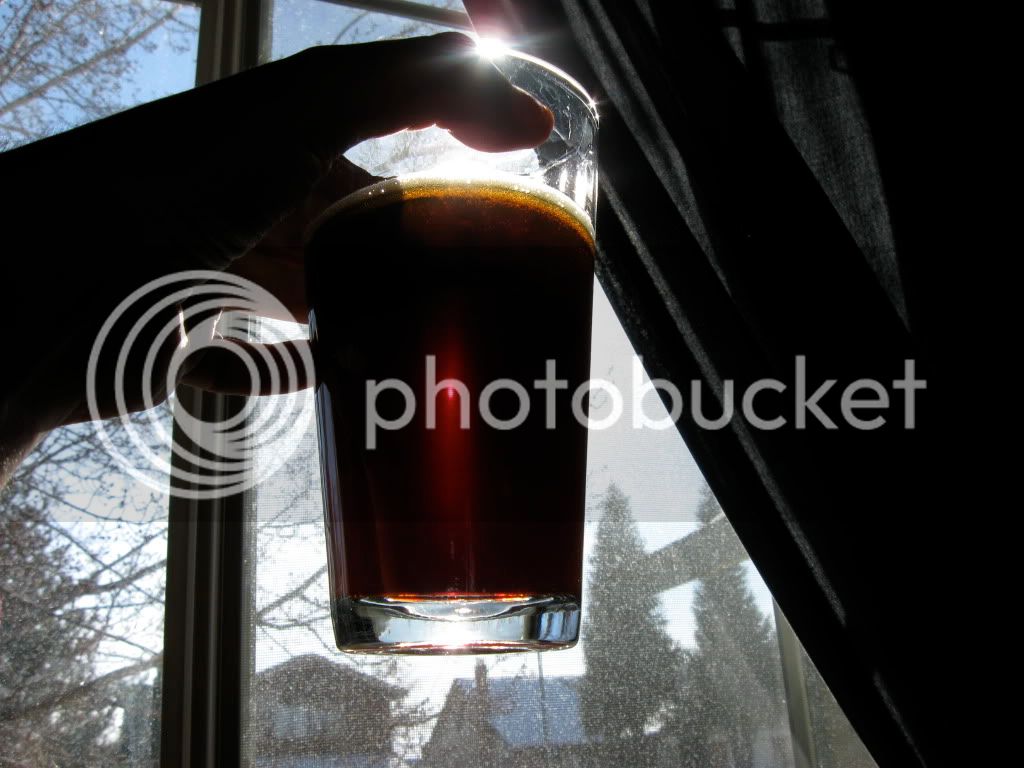- Recipe Type
- Partial Mash
- Yeast
- Wyeast 1728
- Yeast Starter
- 1Qt.
- Additional Yeast or Yeast Starter
- N/A
- Batch Size (Gallons)
- 5
- Original Gravity
- 1.108
- Final Gravity
- 1.030
- Boiling Time (Minutes)
- 60
- IBU
- 43
- Color
- 27
- Primary Fermentation (# of Days & Temp)
- 21 Days at 75F
- Secondary Fermentation (# of Days & Temp)
- 60 Days at 75F
- Tasting Notes
- A strong spiced old ale which is very fruity with sherry like notes.
Grain Bill
Type Color Potential Amount
Pale Ale malt 3L 1.038 4.5lbs
Munich Malt 6L 1.037 4.5lbs
Amber Malt 20L 1.037 3.0lbs
Special B 147L 1.030 1.0lbs
Carafa I 320L 1.032 0.25lbs
Light DME 4L 1.043 5lbs
I did a standard infusion mash at 154deg for 1 hour. I had 4 gallons of strike water and 4 gallons of sparge for a total volume of about 7 gallons going into the brewpot after the grain soaked up a gallon.
Hops
Type Amount Time Alpha
Liberty pellet 1oz 60min 4.5%
Fuggle whole 1oz 60min 4.75%
Liberty pellet 0.5oz 30min 4.5%
Fuggle whole 0.5oz 30min 4.75
Libert pellet 0.5oz 15min 4.5%
Fuggle whole 0.5oz 15min 4.75
Additional ingredients to add at flame out: 1g nutmeg, 1g allspice, 8g ground cinnamon, 4g powdered ginger, 4g of vanilla extract.
Schedule
Pitch yeast at 75F and ferment for 3 weeks. Afterward, obtain 3lbs of dried fruit that you like. I chose 1lb of plums, 1lb of apricots, 1lb of raisins. Put fruit in a bowl and add enough boiling water to cover. Let rehydrate for 1 to 2 hours. Then chill to 70-75 degrees. Transfer fruit with sweet liquid into secondary vessel. Rack beer from primary on top of fruit. Let age for 2 months. Prime with 1/2 cup priming sugar and then bottle. Let carbonate for another 2 months. Enjoy.
UPDATE:
Due to the fact that it may be difficult to clean a glass carboy after having the beer sit on fruit for a couple of months, I recommend this following change to the beer. I recommend three weeks in the primary fermentation, but with a proper yeast starter and fermentation conditions, the bulk of the fermentation will be done in the first week. At this point, you can open your fermentor (I used a plastic bucket) and dump in the fruit. Subsequently, the fermentation should pick up and continue for a few more days. This is a good way to get more out of the yeast in case you get a stuck fermentation. The simple sugars from fruit are easily processed by the yeast and they may finish off any maltose left from the grains and extract. This way, after two more weeks, you can rack off the fruit into a carboy and let age for a good 2 months. Afterwards, you shouldn't have more than just regular sediment in your secondary as opposed to fruit which may be difficult to clean.
Type Color Potential Amount
Pale Ale malt 3L 1.038 4.5lbs
Munich Malt 6L 1.037 4.5lbs
Amber Malt 20L 1.037 3.0lbs
Special B 147L 1.030 1.0lbs
Carafa I 320L 1.032 0.25lbs
Light DME 4L 1.043 5lbs
I did a standard infusion mash at 154deg for 1 hour. I had 4 gallons of strike water and 4 gallons of sparge for a total volume of about 7 gallons going into the brewpot after the grain soaked up a gallon.
Hops
Type Amount Time Alpha
Liberty pellet 1oz 60min 4.5%
Fuggle whole 1oz 60min 4.75%
Liberty pellet 0.5oz 30min 4.5%
Fuggle whole 0.5oz 30min 4.75
Libert pellet 0.5oz 15min 4.5%
Fuggle whole 0.5oz 15min 4.75
Additional ingredients to add at flame out: 1g nutmeg, 1g allspice, 8g ground cinnamon, 4g powdered ginger, 4g of vanilla extract.
Schedule
Pitch yeast at 75F and ferment for 3 weeks. Afterward, obtain 3lbs of dried fruit that you like. I chose 1lb of plums, 1lb of apricots, 1lb of raisins. Put fruit in a bowl and add enough boiling water to cover. Let rehydrate for 1 to 2 hours. Then chill to 70-75 degrees. Transfer fruit with sweet liquid into secondary vessel. Rack beer from primary on top of fruit. Let age for 2 months. Prime with 1/2 cup priming sugar and then bottle. Let carbonate for another 2 months. Enjoy.
UPDATE:
Due to the fact that it may be difficult to clean a glass carboy after having the beer sit on fruit for a couple of months, I recommend this following change to the beer. I recommend three weeks in the primary fermentation, but with a proper yeast starter and fermentation conditions, the bulk of the fermentation will be done in the first week. At this point, you can open your fermentor (I used a plastic bucket) and dump in the fruit. Subsequently, the fermentation should pick up and continue for a few more days. This is a good way to get more out of the yeast in case you get a stuck fermentation. The simple sugars from fruit are easily processed by the yeast and they may finish off any maltose left from the grains and extract. This way, after two more weeks, you can rack off the fruit into a carboy and let age for a good 2 months. Afterwards, you shouldn't have more than just regular sediment in your secondary as opposed to fruit which may be difficult to clean.





